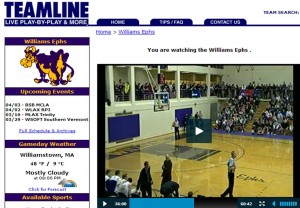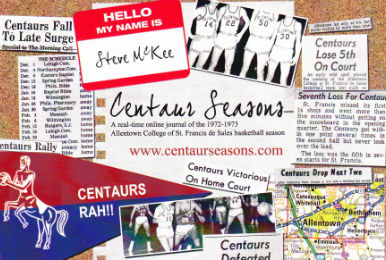Dear Biddy Martin, President, Amherst College; and
Adam Falk, President, Williams College:

The Williams broadcasters aren’t bad but the technology seems straight out of 2003.
Unfortunately, the way most people are viewing your program of late is through your schools’ official athletics webcast, each of which puts your institution in a poor light, for varying reasons.
It’s great that over the years more and more schools have found ways to video stream their games even if it just one camera and no broadcasters. A consistent quality broadcast requires infrastructure, manpower, time and of course, some money, whether you are paying an outside company to host your stream or hosting it on campus.
However, Division III fans, and your institutions deserve better. Amherst and Williams have had plenty of home games this month and have men’s home games on Saturday. You have an opportunity to fix this and raise the bar for this final home game of the season.
It upsets me that not only are these learning experiences that are being thrown away, but also this is the time of year Division III basketball gets to showcase itself and these broadcasts are doing the exact opposite. In order to get the rights to broadcast these games, your institution deals with NCAA partner Turner Sports, which handles rights for all sorts of NCAA Tournament games.
There are requirements and guidelines schools are supposed to follow, including this one:
The Streaming Entity may not denigrate Turner, the NCAA, NCAA member institutions or teams, their players or officials, or any NCAA sport, and must comply in all respects with the NCAA bylaws, rules and regulations in effect, which may be amended from time to time by the NCAA in its sole discretion.
That is pretty important to note. These broadcasts have to have a neutrality to them even if it is a “homer” broadcast team calling the games.
Schools get waivers of the $1,000 per-game rights fees. With that waiver comes those requirements and others, as well as benefits. These broadcasts are linked from NCAA.com as part of the official NCAA bracket, meaning it is being given prominence well beyond your institution and its fanbase. What kind of face does it put on your institution and NCAA Division III in general when your broadcasters act unprofessionally, screaming into the microphones, not bothering to check pronunciations of names, and generally treating the broadcasts as if they were any other fans in the stands rather than spokespersons for your school? That’s how Amherst College portrays itself on its official athletics webcast. If athletics is indeed the front porch of the college, then Amherst’s broadcast makes it look like a frat house.
@sudikoff @lordjeffcast I believe I just heard “Let me get the names right.” Isn’t that something you should know coming into the game?
— Joe Vasile (@JoeVasilePBP) March 9, 2013
Now, on the other hand, Williams has a little more professionalism in the commentary. Saturday’s men’s game was quite well done in that aspect. (More on the women’s games in a bit.) But the broadcast itself looks like a first-generation online broadcast, something straight out of 2003. And that was when the video finally came online at halftime. If athletics is the front porch, then Williams’ broadcast makes it look like a dilapidated shack.
The two young ladies calling the Emory/Whitman women’s game at Williams College on Friday night seemed less like broadcasters and more like two people asked to talk about the game with microphones in front of them. I couldn’t figure out who the play-by-play person or color analyst was – they both talked over each other and didn’t particularly describe the game. The crew that called the games that featured Williams was a bit rough, too. The play-by-play lady kept trying to call the game like she was yukking it up with her friends and even tried several times to bait the color guy into slang comments that made no sense and didn’t have a place for a game many people are watching from around the country. That was especially true considering the participating teams were from Georgia and Washington state.
We know technical problems can plague any webcast, whether hosted on campus or by an outside company. What works once doesn’t necessarily work the next time – instead of broadcaster in my description or Broadcast Director in my D3sports title, it probably should read Broadcast Troubleshooter and Director.
Let’s start with Williams: The video feeds looks like it is from the 1990s. The audio broadcast is even harder to deal with since it sounds like the broadcasters are talking through an old telephone line with absolutely no background noise. It sounds like a game being played in the 1980s.
However, to be honest, I would rather listen to those games than the ones at Amherst.
Those guys clearly have no interest in calling the game with any iota of professionalism. They sounded like they happened to have some microphones and thought it would be cool to call the games for their frat brothers while sitting in the stands. Constant complaining about officials’ calls when they aren’t in favor of the Lord Jeffs; snide comments about the opposing team even one comment, “he celebrated like it was an NBA game, I am not sure what that was all about” which had no context especially since the video feed wasn’t working; overall disdain for anything not in purple; lack of preparation, “I think that is how you say his name, but I need to look that up;” and overall a lack of caring. I even heard the “color analyst” acting like a coach yelling out to an Amherst player to watch out for a defender who was coming in for a double-team at mid-court.
I am shocked that a school like Amherst which has name recognition and often hosts games would allow these two to broadcast. Furthermore, I wonder if the NCAA and Turner Sports are watching these broadcasts since they actually own the content.
Let’s get back to two key points: educational experience and the spotlight on these institutions who are streaming games and for Division III as a whole.
How does a reputable school like Amherst allow a broadcast that is so below amateur to represent it? And how can a very reputable liberal arts college think these broadcasters are getting an educational experience? The players on the court are held at a very high standard when it comes how they conduct themselves. Shouldn’t the same high standards be held to the broadcasters on the official webstream for the college?
This applies to all schools in this situation. I have worked with quite a few where they know this experience is something that can better these students so the mission is to make it part of their college education. I know schools with less name notoriety or attention this time of year who would have pulled the plug on the Amherst broadcasters before the first half even ended!
As for the spotlight, we as a Division III family should be embarrassed and ask for something to be done. This is the division we love and cherish and wish would get more attention from national and even local media. These are teams we know will show the basketball world in Atlanta that the Division III brand of basketball is pretty high-caliber. We are proud of these student-athletes and we are proud of those who support these athletes from their coaches to administrators to even broadcasters. But when you turn on showcased games and broadcasters aren’t respecting the magnitude of the game or the viewers, something needs to be done. These broadcasts may be popular among your alumni, especially your young alumni, because they are energetic, but they sound more like a video game than a college basketball contest.
Next weekend the D3hoops.com crew will be Holland, Mich., for the culmination of the women’s basketball season. And perhaps you will be too, since your teams have advanced. I am half-tempted to cancel my trip if I could travel to Amherst or Williams and show them how a broadcast in the Sweet 16 of the NCAA Division III Men’s Basketball Championship tournament should be done. In fact, I would be willing to travel to St. Mary’s (Md.) who doesn’t have a broadcast so that people can compare how bad those other entities are doing it at schools with plenty more national attention because of their institution’s names than most in Division III. Amherst even had a crew of ours in LeFrak Gymnasium earlier in early February for its doubleheader with Tufts University (men’s game tips off at 52-minute mark of that video). That was a crew made up entirely of former student broadcasters, ones who took the role seriously in their time at Division III schools. All of us at D3hoops.com had microphones in front of our faces as students, and we weren’t perfect, but we took the game seriously and worked hard to make ourselves better, even if we weren’t being mentored by anyone.
Plenty of Division III schools have fantastic student broadcasters, and continue to produce quality broadcasts year after year, even though students graduate and move on. If you are in Holland this weekend, stop and listen to what the students from DePauw University sound like. WGRE has been producing quality broadcasts for years, ones that the entire institution can be proud of and put a fine face on Division III. Other schools do so year after year as well, schools such as Ithaca College, North Central College, Wheaton College (Ill.) and others who take it seriously and would never tolerate the type of broadcasts put out recently by Amherst and Williams.
Division III fans shouldn’t stand for this; you and your institutions shouldn’t stand for this; and those broadcasters should realize they are doing far more than embarrassing themselves. They are embarrassing the student-athletes, the athletic departments, their institutions and Division III as a whole.
Advise your students to take themselves seriously, do their homework and respect their opponents. It’s important not only to know how to pronounce the names of starters but also head coaches and assistant coaches, and whether the opponent’s school goes by College or University. You should listen to their tapes, but more importantly, so should they. That is how you get better as a broadcaster. They should learn not to talk over each other, because usually when two people talk, then neither one can be understood.
But most importantly, what they should learn is that a big game tends to bring a big audience, and they need to elevate their game in response. Just as they wouldn’t expect the players on the floor to revert to a playground game when there is a title on the line, they shouldn’t use those two hours as a time to joke around with their buddies.
Dave McHugh
D3sports.com
 By Steve McKee
By Steve McKee